Budgeting and Forecasting Theory Assessment - FNSACC412/513, 2020
VerifiedAdded on 2022/12/27
|14
|4861
|68
Homework Assignment
AI Summary
This assignment solution addresses key aspects of budgeting and forecasting, including the purposes of preparing budgets and various techniques like traditional, incremental, and zero-based budgeting. It explores different sources of information used in the budgeting process, statistical analysis, and the difference between qualitative and quantitative forecasting methods. The solution also covers forecasting trends, ethical dilemmas, ethical considerations, and the limitations of budget figures. Furthermore, it explains the relevance of KPIs and milestones, the principles of corporate governance, and the main areas of risk in forecasting. The solution provides definitions and examples, discusses the stages of the strategic planning cycle, and lists controllable and non-controllable factors. Finally, it explains the impact of accrual accounting and double-entry bookkeeping on the budgeting process.
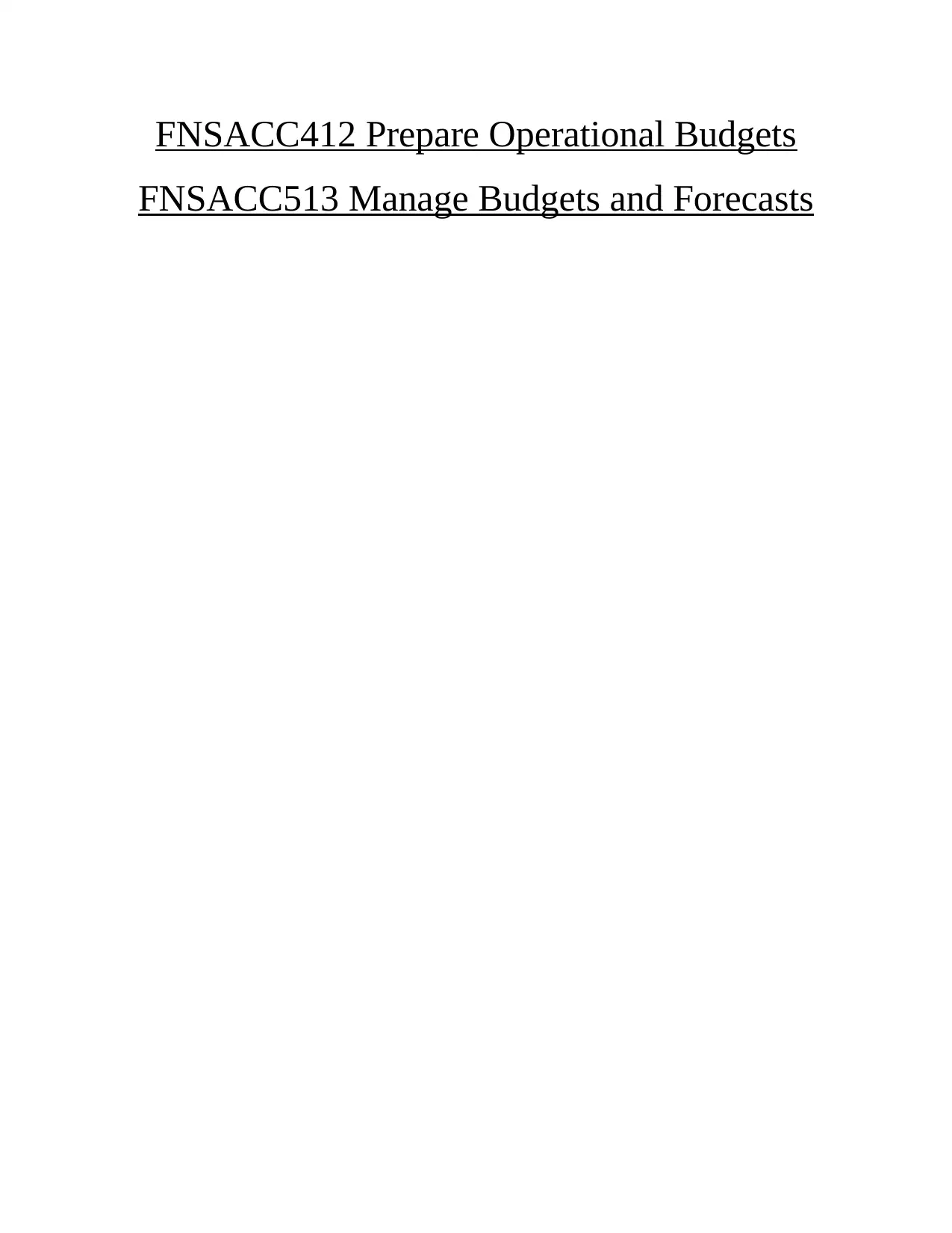
FNSACC412 Prepare Operational Budgets
FNSACC513 Manage Budgets and Forecasts
FNSACC513 Manage Budgets and Forecasts
Paraphrase This Document
Need a fresh take? Get an instant paraphrase of this document with our AI Paraphraser
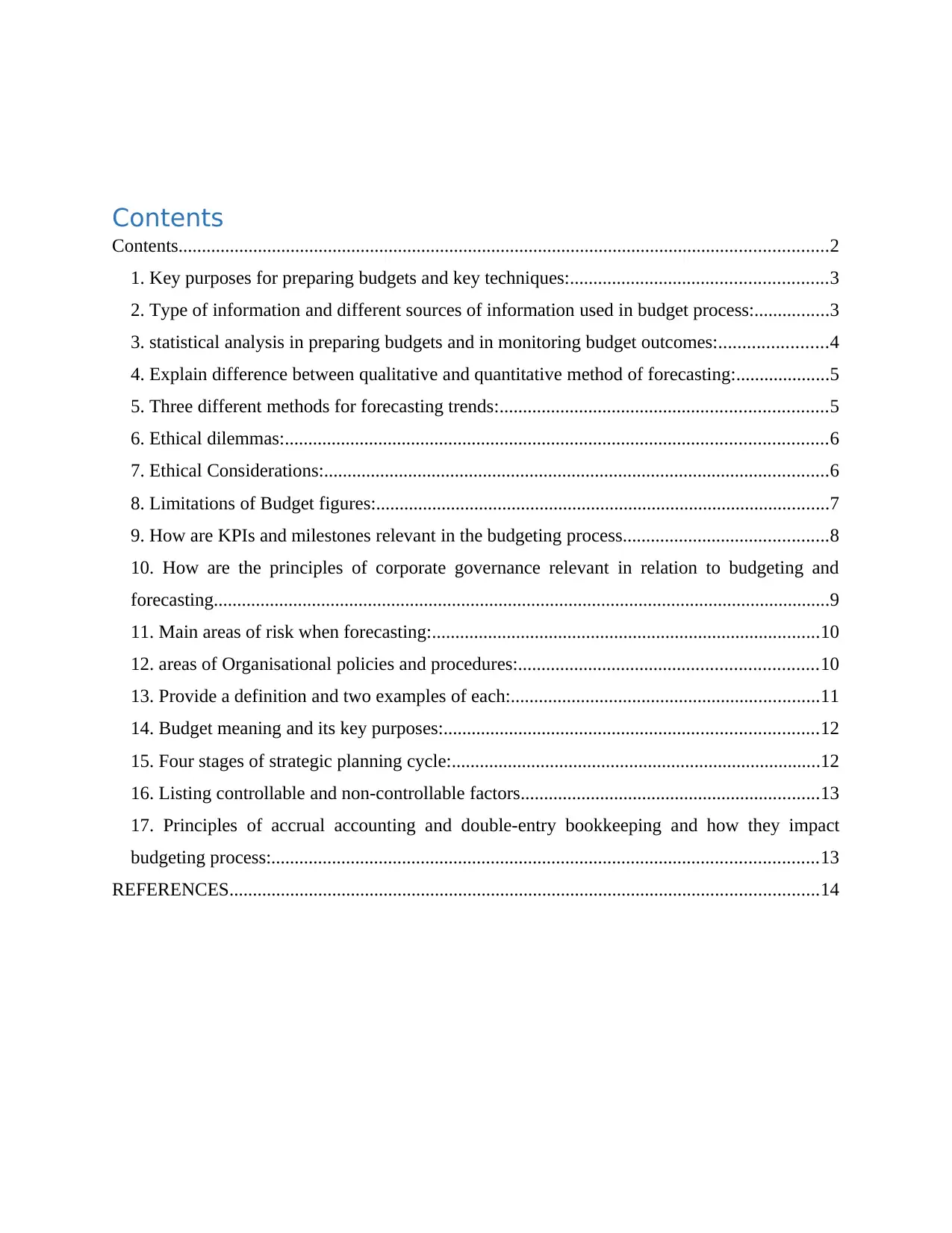
Contents
Contents...........................................................................................................................................2
1. Key purposes for preparing budgets and key techniques:.......................................................3
2. Type of information and different sources of information used in budget process:................3
3. statistical analysis in preparing budgets and in monitoring budget outcomes:.......................4
4. Explain difference between qualitative and quantitative method of forecasting:....................5
5. Three different methods for forecasting trends:......................................................................5
6. Ethical dilemmas:....................................................................................................................6
7. Ethical Considerations:............................................................................................................6
8. Limitations of Budget figures:.................................................................................................7
9. How are KPIs and milestones relevant in the budgeting process............................................8
10. How are the principles of corporate governance relevant in relation to budgeting and
forecasting....................................................................................................................................9
11. Main areas of risk when forecasting:...................................................................................10
12. areas of Organisational policies and procedures:................................................................10
13. Provide a definition and two examples of each:..................................................................11
14. Budget meaning and its key purposes:................................................................................12
15. Four stages of strategic planning cycle:...............................................................................12
16. Listing controllable and non-controllable factors................................................................13
17. Principles of accrual accounting and double-entry bookkeeping and how they impact
budgeting process:.....................................................................................................................13
REFERENCES..............................................................................................................................14
Contents...........................................................................................................................................2
1. Key purposes for preparing budgets and key techniques:.......................................................3
2. Type of information and different sources of information used in budget process:................3
3. statistical analysis in preparing budgets and in monitoring budget outcomes:.......................4
4. Explain difference between qualitative and quantitative method of forecasting:....................5
5. Three different methods for forecasting trends:......................................................................5
6. Ethical dilemmas:....................................................................................................................6
7. Ethical Considerations:............................................................................................................6
8. Limitations of Budget figures:.................................................................................................7
9. How are KPIs and milestones relevant in the budgeting process............................................8
10. How are the principles of corporate governance relevant in relation to budgeting and
forecasting....................................................................................................................................9
11. Main areas of risk when forecasting:...................................................................................10
12. areas of Organisational policies and procedures:................................................................10
13. Provide a definition and two examples of each:..................................................................11
14. Budget meaning and its key purposes:................................................................................12
15. Four stages of strategic planning cycle:...............................................................................12
16. Listing controllable and non-controllable factors................................................................13
17. Principles of accrual accounting and double-entry bookkeeping and how they impact
budgeting process:.....................................................................................................................13
REFERENCES..............................................................................................................................14
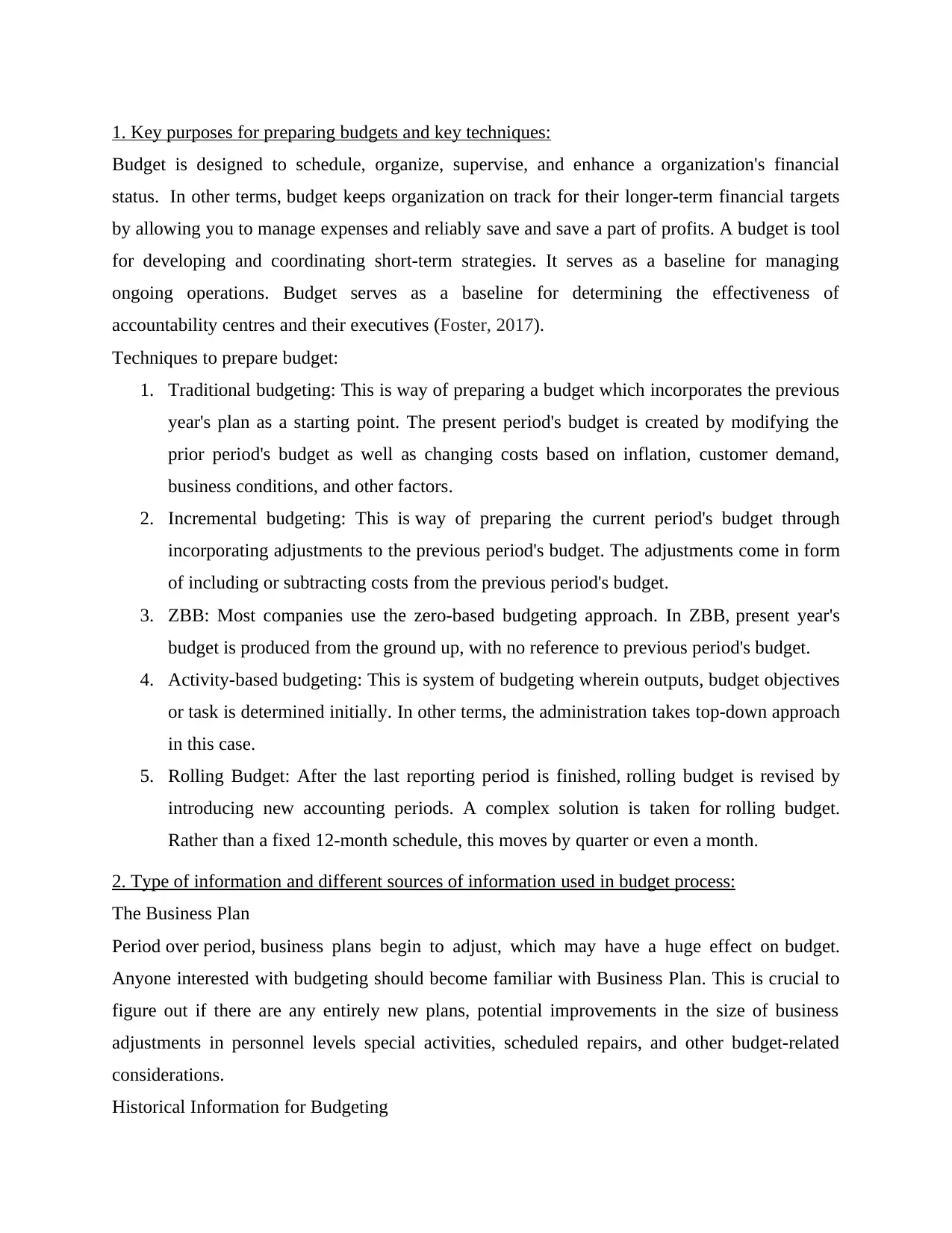
1. Key purposes for preparing budgets and key techniques:
Budget is designed to schedule, organize, supervise, and enhance a organization's financial
status. In other terms, budget keeps organization on track for their longer-term financial targets
by allowing you to manage expenses and reliably save and save a part of profits. A budget is tool
for developing and coordinating short-term strategies. It serves as a baseline for managing
ongoing operations. Budget serves as a baseline for determining the effectiveness of
accountability centres and their executives (Foster, 2017).
Techniques to prepare budget:
1. Traditional budgeting: This is way of preparing a budget which incorporates the previous
year's plan as a starting point. The present period's budget is created by modifying the
prior period's budget as well as changing costs based on inflation, customer demand,
business conditions, and other factors.
2. Incremental budgeting: This is way of preparing the current period's budget through
incorporating adjustments to the previous period's budget. The adjustments come in form
of including or subtracting costs from the previous period's budget.
3. ZBB: Most companies use the zero-based budgeting approach. In ZBB, present year's
budget is produced from the ground up, with no reference to previous period's budget.
4. Activity-based budgeting: This is system of budgeting wherein outputs, budget objectives
or task is determined initially. In other terms, the administration takes top-down approach
in this case.
5. Rolling Budget: After the last reporting period is finished, rolling budget is revised by
introducing new accounting periods. A complex solution is taken for rolling budget.
Rather than a fixed 12-month schedule, this moves by quarter or even a month.
2. Type of information and different sources of information used in budget process:
The Business Plan
Period over period, business plans begin to adjust, which may have a huge effect on budget.
Anyone interested with budgeting should become familiar with Business Plan. This is crucial to
figure out if there are any entirely new plans, potential improvements in the size of business
adjustments in personnel levels special activities, scheduled repairs, and other budget-related
considerations.
Historical Information for Budgeting
Budget is designed to schedule, organize, supervise, and enhance a organization's financial
status. In other terms, budget keeps organization on track for their longer-term financial targets
by allowing you to manage expenses and reliably save and save a part of profits. A budget is tool
for developing and coordinating short-term strategies. It serves as a baseline for managing
ongoing operations. Budget serves as a baseline for determining the effectiveness of
accountability centres and their executives (Foster, 2017).
Techniques to prepare budget:
1. Traditional budgeting: This is way of preparing a budget which incorporates the previous
year's plan as a starting point. The present period's budget is created by modifying the
prior period's budget as well as changing costs based on inflation, customer demand,
business conditions, and other factors.
2. Incremental budgeting: This is way of preparing the current period's budget through
incorporating adjustments to the previous period's budget. The adjustments come in form
of including or subtracting costs from the previous period's budget.
3. ZBB: Most companies use the zero-based budgeting approach. In ZBB, present year's
budget is produced from the ground up, with no reference to previous period's budget.
4. Activity-based budgeting: This is system of budgeting wherein outputs, budget objectives
or task is determined initially. In other terms, the administration takes top-down approach
in this case.
5. Rolling Budget: After the last reporting period is finished, rolling budget is revised by
introducing new accounting periods. A complex solution is taken for rolling budget.
Rather than a fixed 12-month schedule, this moves by quarter or even a month.
2. Type of information and different sources of information used in budget process:
The Business Plan
Period over period, business plans begin to adjust, which may have a huge effect on budget.
Anyone interested with budgeting should become familiar with Business Plan. This is crucial to
figure out if there are any entirely new plans, potential improvements in the size of business
adjustments in personnel levels special activities, scheduled repairs, and other budget-related
considerations.
Historical Information for Budgeting
⊘ This is a preview!⊘
Do you want full access?
Subscribe today to unlock all pages.

Trusted by 1+ million students worldwide
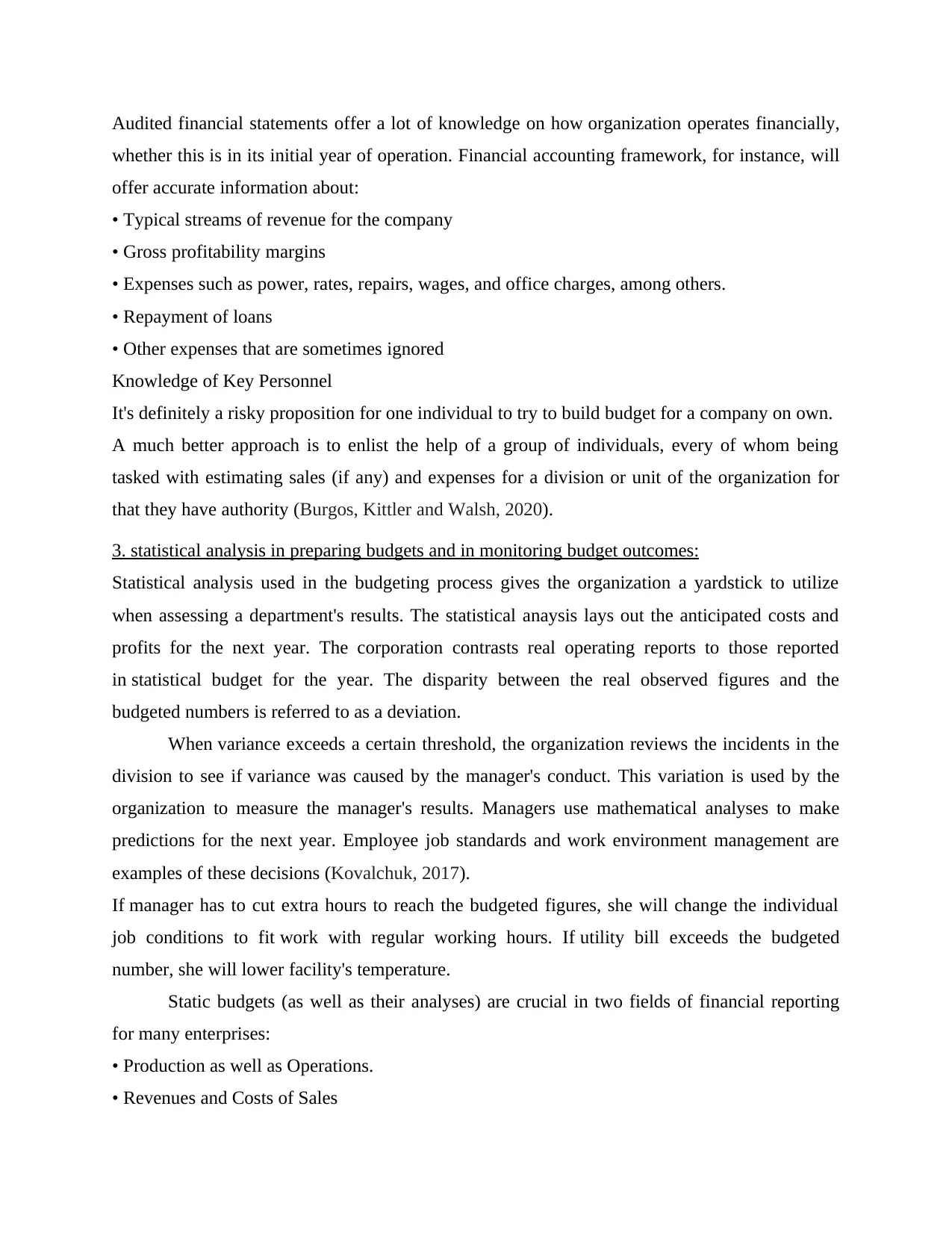
Audited financial statements offer a lot of knowledge on how organization operates financially,
whether this is in its initial year of operation. Financial accounting framework, for instance, will
offer accurate information about:
• Typical streams of revenue for the company
• Gross profitability margins
• Expenses such as power, rates, repairs, wages, and office charges, among others.
• Repayment of loans
• Other expenses that are sometimes ignored
Knowledge of Key Personnel
It's definitely a risky proposition for one individual to try to build budget for a company on own.
A much better approach is to enlist the help of a group of individuals, every of whom being
tasked with estimating sales (if any) and expenses for a division or unit of the organization for
that they have authority (Burgos, Kittler and Walsh, 2020).
3. statistical analysis in preparing budgets and in monitoring budget outcomes:
Statistical analysis used in the budgeting process gives the organization a yardstick to utilize
when assessing a department's results. The statistical anaysis lays out the anticipated costs and
profits for the next year. The corporation contrasts real operating reports to those reported
in statistical budget for the year. The disparity between the real observed figures and the
budgeted numbers is referred to as a deviation.
When variance exceeds a certain threshold, the organization reviews the incidents in the
division to see if variance was caused by the manager's conduct. This variation is used by the
organization to measure the manager's results. Managers use mathematical analyses to make
predictions for the next year. Employee job standards and work environment management are
examples of these decisions (Kovalchuk, 2017).
If manager has to cut extra hours to reach the budgeted figures, she will change the individual
job conditions to fit work with regular working hours. If utility bill exceeds the budgeted
number, she will lower facility's temperature.
Static budgets (as well as their analyses) are crucial in two fields of financial reporting
for many enterprises:
• Production as well as Operations.
• Revenues and Costs of Sales
whether this is in its initial year of operation. Financial accounting framework, for instance, will
offer accurate information about:
• Typical streams of revenue for the company
• Gross profitability margins
• Expenses such as power, rates, repairs, wages, and office charges, among others.
• Repayment of loans
• Other expenses that are sometimes ignored
Knowledge of Key Personnel
It's definitely a risky proposition for one individual to try to build budget for a company on own.
A much better approach is to enlist the help of a group of individuals, every of whom being
tasked with estimating sales (if any) and expenses for a division or unit of the organization for
that they have authority (Burgos, Kittler and Walsh, 2020).
3. statistical analysis in preparing budgets and in monitoring budget outcomes:
Statistical analysis used in the budgeting process gives the organization a yardstick to utilize
when assessing a department's results. The statistical anaysis lays out the anticipated costs and
profits for the next year. The corporation contrasts real operating reports to those reported
in statistical budget for the year. The disparity between the real observed figures and the
budgeted numbers is referred to as a deviation.
When variance exceeds a certain threshold, the organization reviews the incidents in the
division to see if variance was caused by the manager's conduct. This variation is used by the
organization to measure the manager's results. Managers use mathematical analyses to make
predictions for the next year. Employee job standards and work environment management are
examples of these decisions (Kovalchuk, 2017).
If manager has to cut extra hours to reach the budgeted figures, she will change the individual
job conditions to fit work with regular working hours. If utility bill exceeds the budgeted
number, she will lower facility's temperature.
Static budgets (as well as their analyses) are crucial in two fields of financial reporting
for many enterprises:
• Production as well as Operations.
• Revenues and Costs of Sales
Paraphrase This Document
Need a fresh take? Get an instant paraphrase of this document with our AI Paraphraser
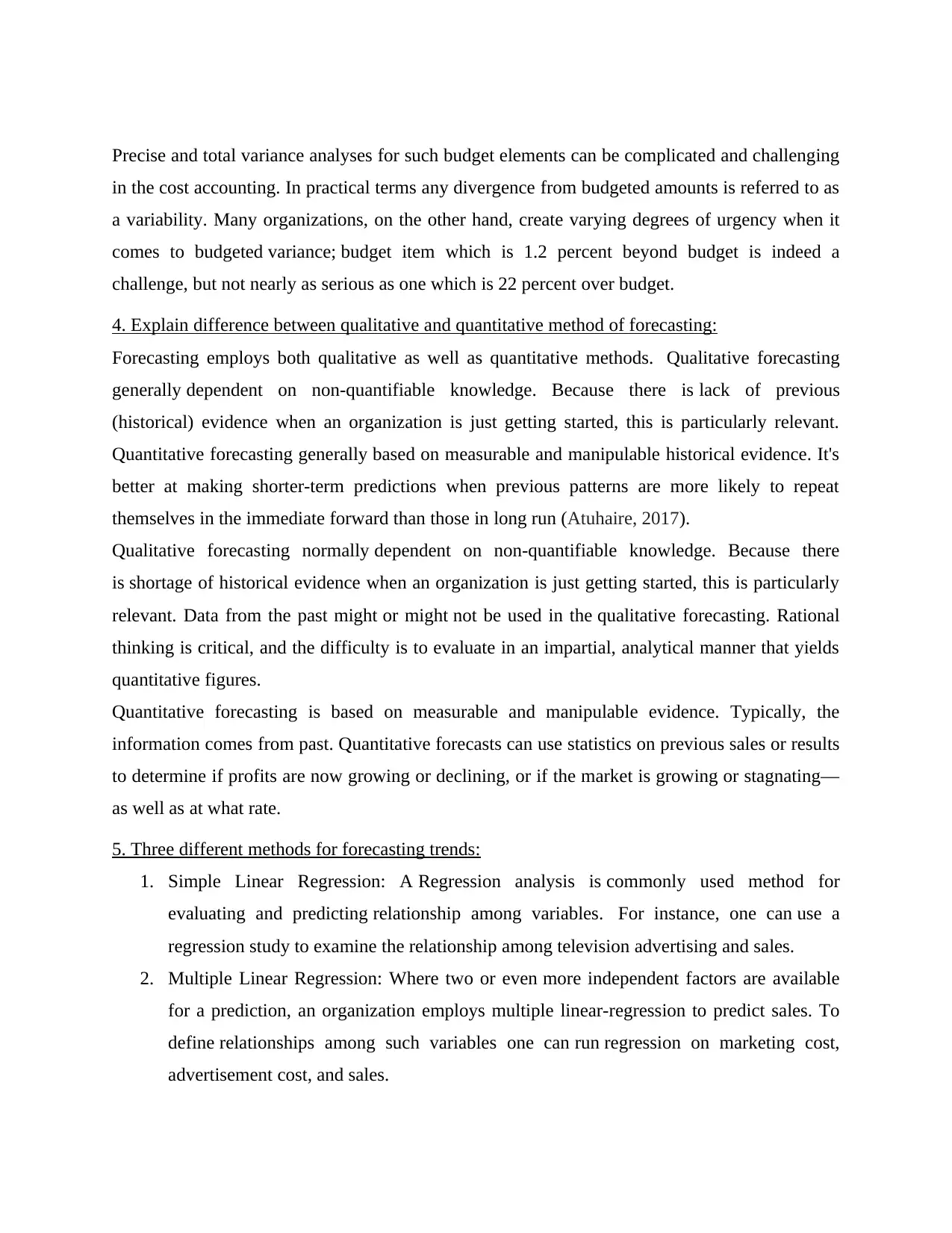
Precise and total variance analyses for such budget elements can be complicated and challenging
in the cost accounting. In practical terms any divergence from budgeted amounts is referred to as
a variability. Many organizations, on the other hand, create varying degrees of urgency when it
comes to budgeted variance; budget item which is 1.2 percent beyond budget is indeed a
challenge, but not nearly as serious as one which is 22 percent over budget.
4. Explain difference between qualitative and quantitative method of forecasting:
Forecasting employs both qualitative as well as quantitative methods. Qualitative forecasting
generally dependent on non-quantifiable knowledge. Because there is lack of previous
(historical) evidence when an organization is just getting started, this is particularly relevant.
Quantitative forecasting generally based on measurable and manipulable historical evidence. It's
better at making shorter-term predictions when previous patterns are more likely to repeat
themselves in the immediate forward than those in long run (Atuhaire, 2017).
Qualitative forecasting normally dependent on non-quantifiable knowledge. Because there
is shortage of historical evidence when an organization is just getting started, this is particularly
relevant. Data from the past might or might not be used in the qualitative forecasting. Rational
thinking is critical, and the difficulty is to evaluate in an impartial, analytical manner that yields
quantitative figures.
Quantitative forecasting is based on measurable and manipulable evidence. Typically, the
information comes from past. Quantitative forecasts can use statistics on previous sales or results
to determine if profits are now growing or declining, or if the market is growing or stagnating—
as well as at what rate.
5. Three different methods for forecasting trends:
1. Simple Linear Regression: A Regression analysis is commonly used method for
evaluating and predicting relationship among variables. For instance, one can use a
regression study to examine the relationship among television advertising and sales.
2. Multiple Linear Regression: Where two or even more independent factors are available
for a prediction, an organization employs multiple linear-regression to predict sales. To
define relationships among such variables one can run regression on marketing cost,
advertisement cost, and sales.
in the cost accounting. In practical terms any divergence from budgeted amounts is referred to as
a variability. Many organizations, on the other hand, create varying degrees of urgency when it
comes to budgeted variance; budget item which is 1.2 percent beyond budget is indeed a
challenge, but not nearly as serious as one which is 22 percent over budget.
4. Explain difference between qualitative and quantitative method of forecasting:
Forecasting employs both qualitative as well as quantitative methods. Qualitative forecasting
generally dependent on non-quantifiable knowledge. Because there is lack of previous
(historical) evidence when an organization is just getting started, this is particularly relevant.
Quantitative forecasting generally based on measurable and manipulable historical evidence. It's
better at making shorter-term predictions when previous patterns are more likely to repeat
themselves in the immediate forward than those in long run (Atuhaire, 2017).
Qualitative forecasting normally dependent on non-quantifiable knowledge. Because there
is shortage of historical evidence when an organization is just getting started, this is particularly
relevant. Data from the past might or might not be used in the qualitative forecasting. Rational
thinking is critical, and the difficulty is to evaluate in an impartial, analytical manner that yields
quantitative figures.
Quantitative forecasting is based on measurable and manipulable evidence. Typically, the
information comes from past. Quantitative forecasts can use statistics on previous sales or results
to determine if profits are now growing or declining, or if the market is growing or stagnating—
as well as at what rate.
5. Three different methods for forecasting trends:
1. Simple Linear Regression: A Regression analysis is commonly used method for
evaluating and predicting relationship among variables. For instance, one can use a
regression study to examine the relationship among television advertising and sales.
2. Multiple Linear Regression: Where two or even more independent factors are available
for a prediction, an organization employs multiple linear-regression to predict sales. To
define relationships among such variables one can run regression on marketing cost,
advertisement cost, and sales.
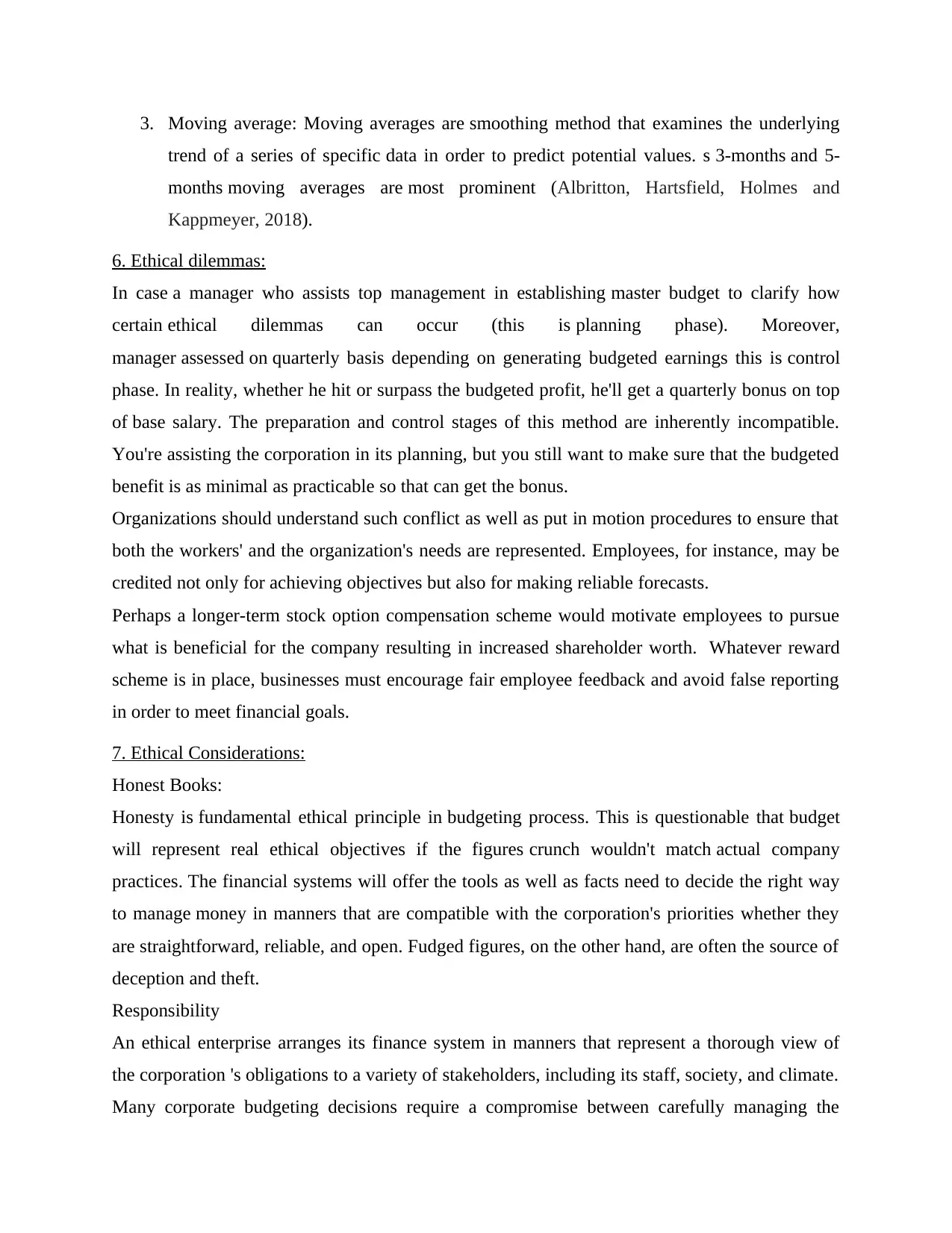
3. Moving average: Moving averages are smoothing method that examines the underlying
trend of a series of specific data in order to predict potential values. s 3-months and 5-
months moving averages are most prominent (Albritton, Hartsfield, Holmes and
Kappmeyer, 2018).
6. Ethical dilemmas:
In case a manager who assists top management in establishing master budget to clarify how
certain ethical dilemmas can occur (this is planning phase). Moreover,
manager assessed on quarterly basis depending on generating budgeted earnings this is control
phase. In reality, whether he hit or surpass the budgeted profit, he'll get a quarterly bonus on top
of base salary. The preparation and control stages of this method are inherently incompatible.
You're assisting the corporation in its planning, but you still want to make sure that the budgeted
benefit is as minimal as practicable so that can get the bonus.
Organizations should understand such conflict as well as put in motion procedures to ensure that
both the workers' and the organization's needs are represented. Employees, for instance, may be
credited not only for achieving objectives but also for making reliable forecasts.
Perhaps a longer-term stock option compensation scheme would motivate employees to pursue
what is beneficial for the company resulting in increased shareholder worth. Whatever reward
scheme is in place, businesses must encourage fair employee feedback and avoid false reporting
in order to meet financial goals.
7. Ethical Considerations:
Honest Books:
Honesty is fundamental ethical principle in budgeting process. This is questionable that budget
will represent real ethical objectives if the figures crunch wouldn't match actual company
practices. The financial systems will offer the tools as well as facts need to decide the right way
to manage money in manners that are compatible with the corporation's priorities whether they
are straightforward, reliable, and open. Fudged figures, on the other hand, are often the source of
deception and theft.
Responsibility
An ethical enterprise arranges its finance system in manners that represent a thorough view of
the corporation 's obligations to a variety of stakeholders, including its staff, society, and climate.
Many corporate budgeting decisions require a compromise between carefully managing the
trend of a series of specific data in order to predict potential values. s 3-months and 5-
months moving averages are most prominent (Albritton, Hartsfield, Holmes and
Kappmeyer, 2018).
6. Ethical dilemmas:
In case a manager who assists top management in establishing master budget to clarify how
certain ethical dilemmas can occur (this is planning phase). Moreover,
manager assessed on quarterly basis depending on generating budgeted earnings this is control
phase. In reality, whether he hit or surpass the budgeted profit, he'll get a quarterly bonus on top
of base salary. The preparation and control stages of this method are inherently incompatible.
You're assisting the corporation in its planning, but you still want to make sure that the budgeted
benefit is as minimal as practicable so that can get the bonus.
Organizations should understand such conflict as well as put in motion procedures to ensure that
both the workers' and the organization's needs are represented. Employees, for instance, may be
credited not only for achieving objectives but also for making reliable forecasts.
Perhaps a longer-term stock option compensation scheme would motivate employees to pursue
what is beneficial for the company resulting in increased shareholder worth. Whatever reward
scheme is in place, businesses must encourage fair employee feedback and avoid false reporting
in order to meet financial goals.
7. Ethical Considerations:
Honest Books:
Honesty is fundamental ethical principle in budgeting process. This is questionable that budget
will represent real ethical objectives if the figures crunch wouldn't match actual company
practices. The financial systems will offer the tools as well as facts need to decide the right way
to manage money in manners that are compatible with the corporation's priorities whether they
are straightforward, reliable, and open. Fudged figures, on the other hand, are often the source of
deception and theft.
Responsibility
An ethical enterprise arranges its finance system in manners that represent a thorough view of
the corporation 's obligations to a variety of stakeholders, including its staff, society, and climate.
Many corporate budgeting decisions require a compromise between carefully managing the
⊘ This is a preview!⊘
Do you want full access?
Subscribe today to unlock all pages.

Trusted by 1+ million students worldwide
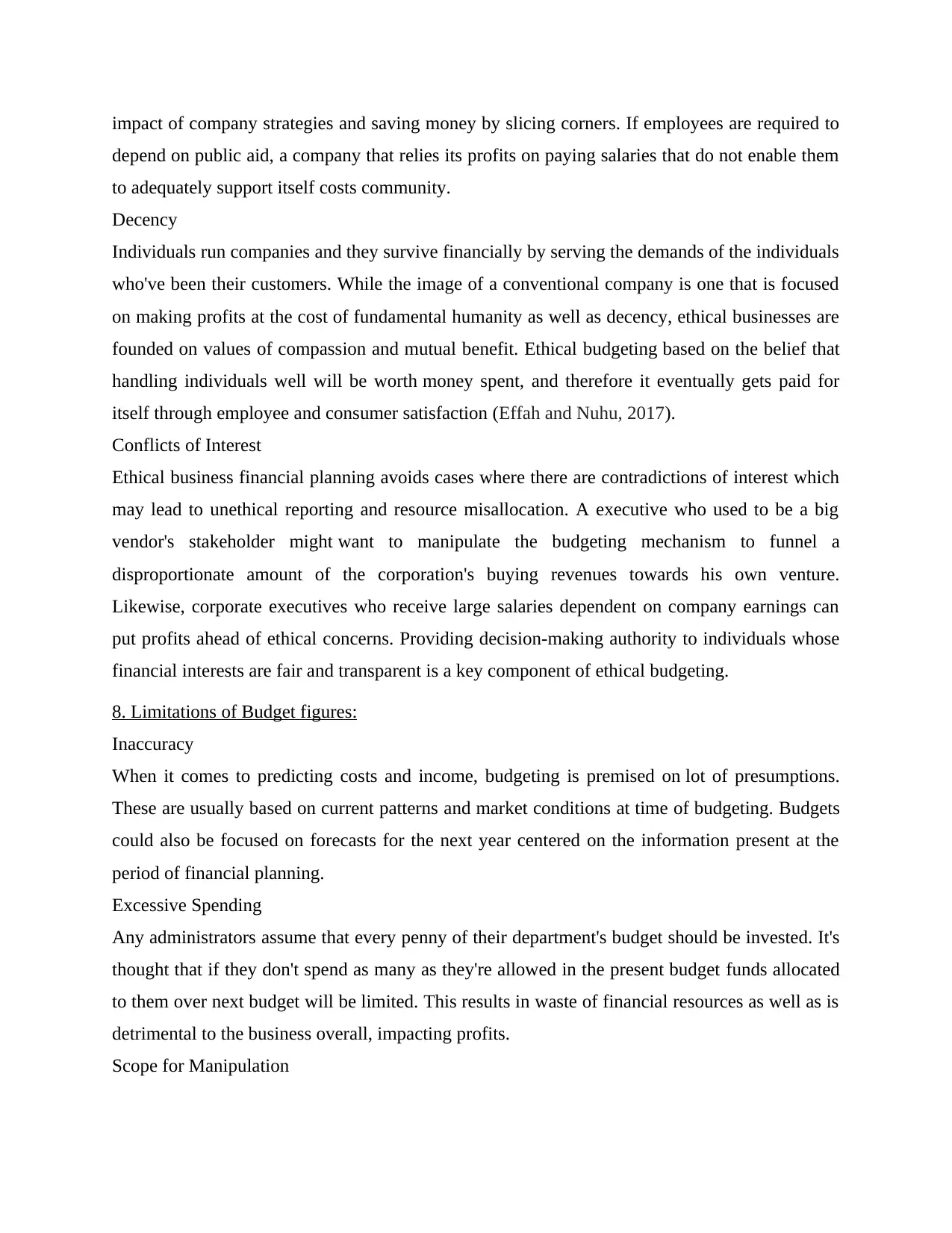
impact of company strategies and saving money by slicing corners. If employees are required to
depend on public aid, a company that relies its profits on paying salaries that do not enable them
to adequately support itself costs community.
Decency
Individuals run companies and they survive financially by serving the demands of the individuals
who've been their customers. While the image of a conventional company is one that is focused
on making profits at the cost of fundamental humanity as well as decency, ethical businesses are
founded on values of compassion and mutual benefit. Ethical budgeting based on the belief that
handling individuals well will be worth money spent, and therefore it eventually gets paid for
itself through employee and consumer satisfaction (Effah and Nuhu, 2017).
Conflicts of Interest
Ethical business financial planning avoids cases where there are contradictions of interest which
may lead to unethical reporting and resource misallocation. A executive who used to be a big
vendor's stakeholder might want to manipulate the budgeting mechanism to funnel a
disproportionate amount of the corporation's buying revenues towards his own venture.
Likewise, corporate executives who receive large salaries dependent on company earnings can
put profits ahead of ethical concerns. Providing decision-making authority to individuals whose
financial interests are fair and transparent is a key component of ethical budgeting.
8. Limitations of Budget figures:
Inaccuracy
When it comes to predicting costs and income, budgeting is premised on lot of presumptions.
These are usually based on current patterns and market conditions at time of budgeting. Budgets
could also be focused on forecasts for the next year centered on the information present at the
period of financial planning.
Excessive Spending
Any administrators assume that every penny of their department's budget should be invested. It's
thought that if they don't spend as many as they're allowed in the present budget funds allocated
to them over next budget will be limited. This results in waste of financial resources as well as is
detrimental to the business overall, impacting profits.
Scope for Manipulation
depend on public aid, a company that relies its profits on paying salaries that do not enable them
to adequately support itself costs community.
Decency
Individuals run companies and they survive financially by serving the demands of the individuals
who've been their customers. While the image of a conventional company is one that is focused
on making profits at the cost of fundamental humanity as well as decency, ethical businesses are
founded on values of compassion and mutual benefit. Ethical budgeting based on the belief that
handling individuals well will be worth money spent, and therefore it eventually gets paid for
itself through employee and consumer satisfaction (Effah and Nuhu, 2017).
Conflicts of Interest
Ethical business financial planning avoids cases where there are contradictions of interest which
may lead to unethical reporting and resource misallocation. A executive who used to be a big
vendor's stakeholder might want to manipulate the budgeting mechanism to funnel a
disproportionate amount of the corporation's buying revenues towards his own venture.
Likewise, corporate executives who receive large salaries dependent on company earnings can
put profits ahead of ethical concerns. Providing decision-making authority to individuals whose
financial interests are fair and transparent is a key component of ethical budgeting.
8. Limitations of Budget figures:
Inaccuracy
When it comes to predicting costs and income, budgeting is premised on lot of presumptions.
These are usually based on current patterns and market conditions at time of budgeting. Budgets
could also be focused on forecasts for the next year centered on the information present at the
period of financial planning.
Excessive Spending
Any administrators assume that every penny of their department's budget should be invested. It's
thought that if they don't spend as many as they're allowed in the present budget funds allocated
to them over next budget will be limited. This results in waste of financial resources as well as is
detrimental to the business overall, impacting profits.
Scope for Manipulation
Paraphrase This Document
Need a fresh take? Get an instant paraphrase of this document with our AI Paraphraser
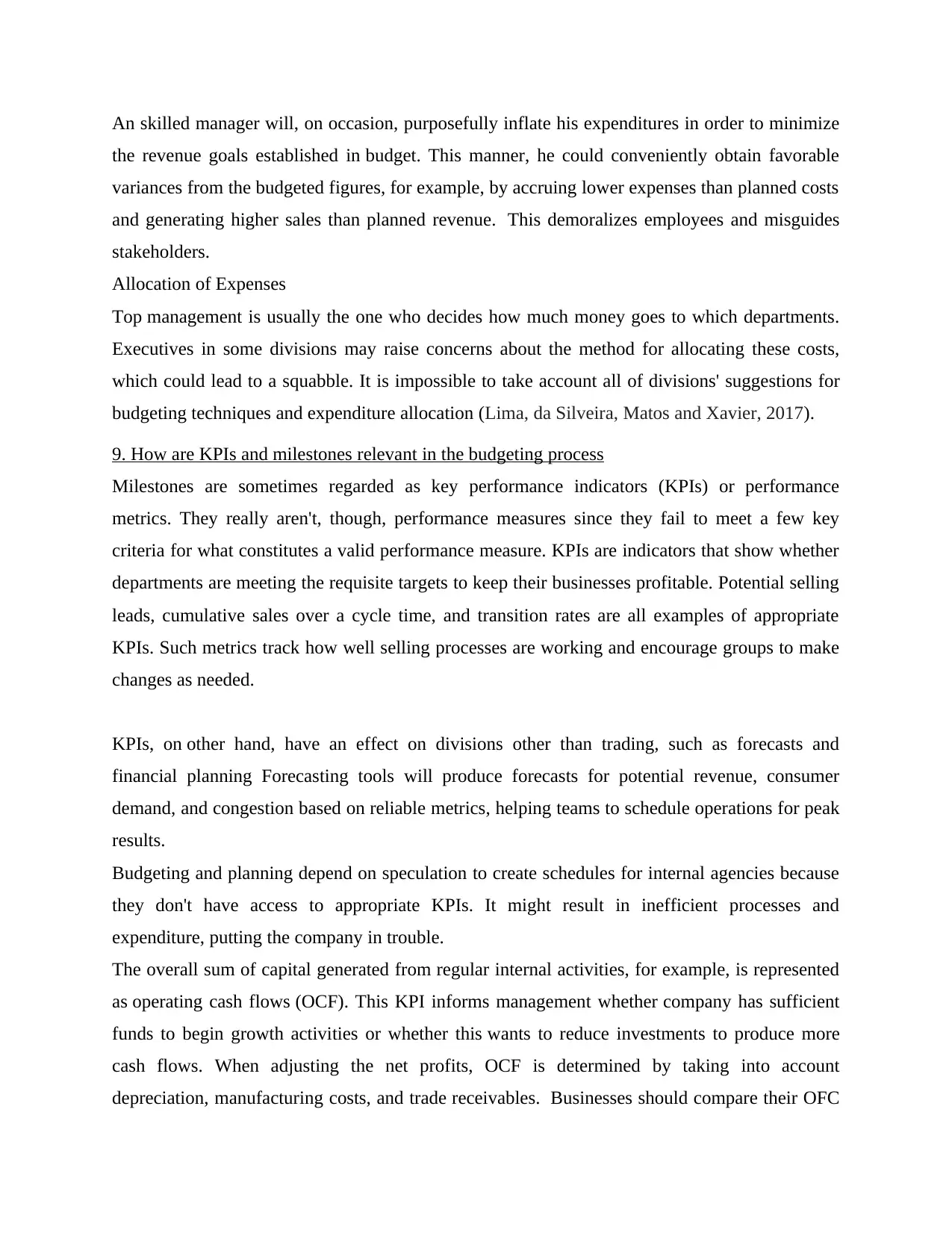
An skilled manager will, on occasion, purposefully inflate his expenditures in order to minimize
the revenue goals established in budget. This manner, he could conveniently obtain favorable
variances from the budgeted figures, for example, by accruing lower expenses than planned costs
and generating higher sales than planned revenue. This demoralizes employees and misguides
stakeholders.
Allocation of Expenses
Top management is usually the one who decides how much money goes to which departments.
Executives in some divisions may raise concerns about the method for allocating these costs,
which could lead to a squabble. It is impossible to take account all of divisions' suggestions for
budgeting techniques and expenditure allocation (Lima, da Silveira, Matos and Xavier, 2017).
9. How are KPIs and milestones relevant in the budgeting process
Milestones are sometimes regarded as key performance indicators (KPIs) or performance
metrics. They really aren't, though, performance measures since they fail to meet a few key
criteria for what constitutes a valid performance measure. KPIs are indicators that show whether
departments are meeting the requisite targets to keep their businesses profitable. Potential selling
leads, cumulative sales over a cycle time, and transition rates are all examples of appropriate
KPIs. Such metrics track how well selling processes are working and encourage groups to make
changes as needed.
KPIs, on other hand, have an effect on divisions other than trading, such as forecasts and
financial planning Forecasting tools will produce forecasts for potential revenue, consumer
demand, and congestion based on reliable metrics, helping teams to schedule operations for peak
results.
Budgeting and planning depend on speculation to create schedules for internal agencies because
they don't have access to appropriate KPIs. It might result in inefficient processes and
expenditure, putting the company in trouble.
The overall sum of capital generated from regular internal activities, for example, is represented
as operating cash flows (OCF). This KPI informs management whether company has sufficient
funds to begin growth activities or whether this wants to reduce investments to produce more
cash flows. When adjusting the net profits, OCF is determined by taking into account
depreciation, manufacturing costs, and trade receivables. Businesses should compare their OFC
the revenue goals established in budget. This manner, he could conveniently obtain favorable
variances from the budgeted figures, for example, by accruing lower expenses than planned costs
and generating higher sales than planned revenue. This demoralizes employees and misguides
stakeholders.
Allocation of Expenses
Top management is usually the one who decides how much money goes to which departments.
Executives in some divisions may raise concerns about the method for allocating these costs,
which could lead to a squabble. It is impossible to take account all of divisions' suggestions for
budgeting techniques and expenditure allocation (Lima, da Silveira, Matos and Xavier, 2017).
9. How are KPIs and milestones relevant in the budgeting process
Milestones are sometimes regarded as key performance indicators (KPIs) or performance
metrics. They really aren't, though, performance measures since they fail to meet a few key
criteria for what constitutes a valid performance measure. KPIs are indicators that show whether
departments are meeting the requisite targets to keep their businesses profitable. Potential selling
leads, cumulative sales over a cycle time, and transition rates are all examples of appropriate
KPIs. Such metrics track how well selling processes are working and encourage groups to make
changes as needed.
KPIs, on other hand, have an effect on divisions other than trading, such as forecasts and
financial planning Forecasting tools will produce forecasts for potential revenue, consumer
demand, and congestion based on reliable metrics, helping teams to schedule operations for peak
results.
Budgeting and planning depend on speculation to create schedules for internal agencies because
they don't have access to appropriate KPIs. It might result in inefficient processes and
expenditure, putting the company in trouble.
The overall sum of capital generated from regular internal activities, for example, is represented
as operating cash flows (OCF). This KPI informs management whether company has sufficient
funds to begin growth activities or whether this wants to reduce investments to produce more
cash flows. When adjusting the net profits, OCF is determined by taking into account
depreciation, manufacturing costs, and trade receivables. Businesses should compare their OFC
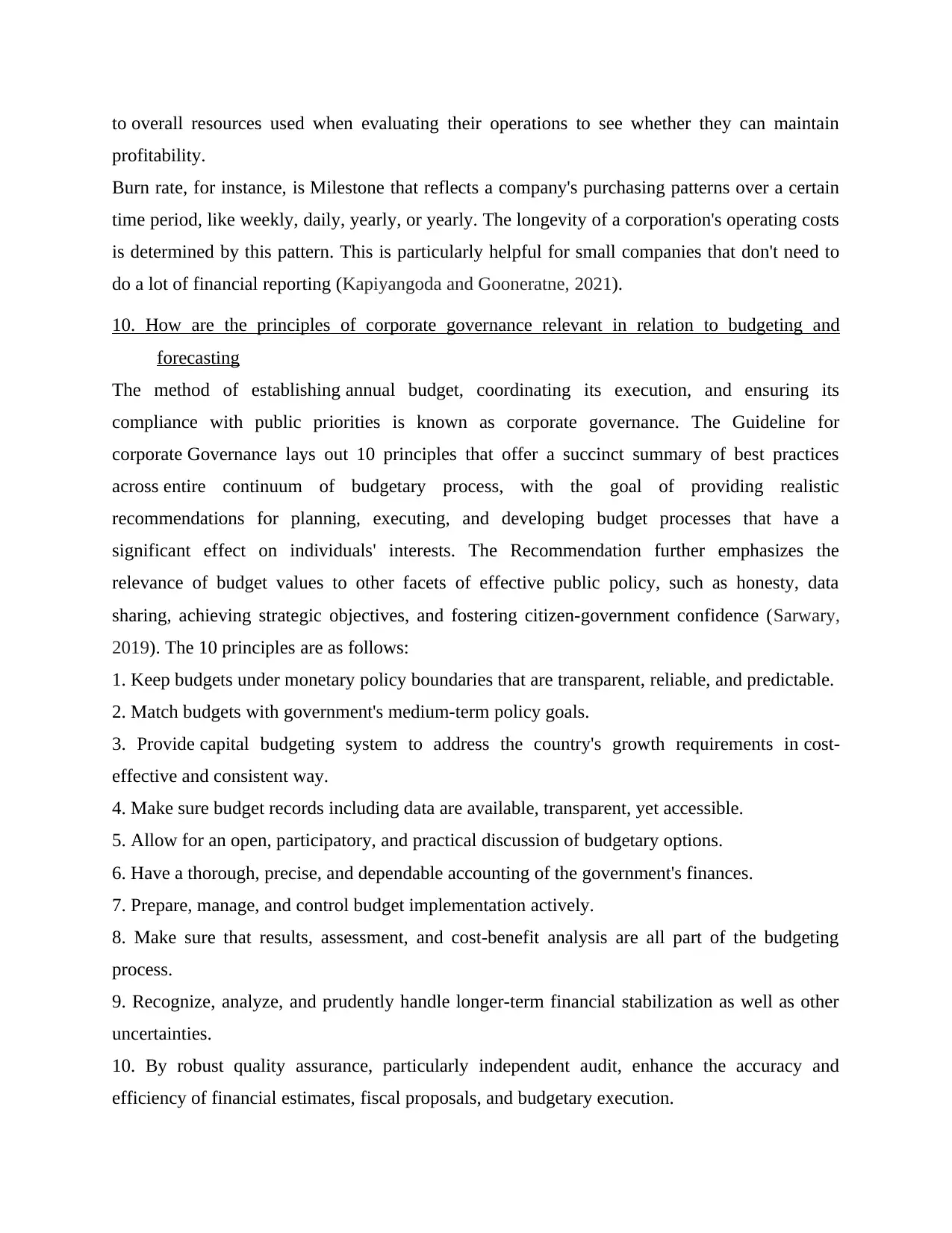
to overall resources used when evaluating their operations to see whether they can maintain
profitability.
Burn rate, for instance, is Milestone that reflects a company's purchasing patterns over a certain
time period, like weekly, daily, yearly, or yearly. The longevity of a corporation's operating costs
is determined by this pattern. This is particularly helpful for small companies that don't need to
do a lot of financial reporting (Kapiyangoda and Gooneratne, 2021).
10. How are the principles of corporate governance relevant in relation to budgeting and
forecasting
The method of establishing annual budget, coordinating its execution, and ensuring its
compliance with public priorities is known as corporate governance. The Guideline for
corporate Governance lays out 10 principles that offer a succinct summary of best practices
across entire continuum of budgetary process, with the goal of providing realistic
recommendations for planning, executing, and developing budget processes that have a
significant effect on individuals' interests. The Recommendation further emphasizes the
relevance of budget values to other facets of effective public policy, such as honesty, data
sharing, achieving strategic objectives, and fostering citizen-government confidence (Sarwary,
2019). The 10 principles are as follows:
1. Keep budgets under monetary policy boundaries that are transparent, reliable, and predictable.
2. Match budgets with government's medium-term policy goals.
3. Provide capital budgeting system to address the country's growth requirements in cost-
effective and consistent way.
4. Make sure budget records including data are available, transparent, yet accessible.
5. Allow for an open, participatory, and practical discussion of budgetary options.
6. Have a thorough, precise, and dependable accounting of the government's finances.
7. Prepare, manage, and control budget implementation actively.
8. Make sure that results, assessment, and cost-benefit analysis are all part of the budgeting
process.
9. Recognize, analyze, and prudently handle longer-term financial stabilization as well as other
uncertainties.
10. By robust quality assurance, particularly independent audit, enhance the accuracy and
efficiency of financial estimates, fiscal proposals, and budgetary execution.
profitability.
Burn rate, for instance, is Milestone that reflects a company's purchasing patterns over a certain
time period, like weekly, daily, yearly, or yearly. The longevity of a corporation's operating costs
is determined by this pattern. This is particularly helpful for small companies that don't need to
do a lot of financial reporting (Kapiyangoda and Gooneratne, 2021).
10. How are the principles of corporate governance relevant in relation to budgeting and
forecasting
The method of establishing annual budget, coordinating its execution, and ensuring its
compliance with public priorities is known as corporate governance. The Guideline for
corporate Governance lays out 10 principles that offer a succinct summary of best practices
across entire continuum of budgetary process, with the goal of providing realistic
recommendations for planning, executing, and developing budget processes that have a
significant effect on individuals' interests. The Recommendation further emphasizes the
relevance of budget values to other facets of effective public policy, such as honesty, data
sharing, achieving strategic objectives, and fostering citizen-government confidence (Sarwary,
2019). The 10 principles are as follows:
1. Keep budgets under monetary policy boundaries that are transparent, reliable, and predictable.
2. Match budgets with government's medium-term policy goals.
3. Provide capital budgeting system to address the country's growth requirements in cost-
effective and consistent way.
4. Make sure budget records including data are available, transparent, yet accessible.
5. Allow for an open, participatory, and practical discussion of budgetary options.
6. Have a thorough, precise, and dependable accounting of the government's finances.
7. Prepare, manage, and control budget implementation actively.
8. Make sure that results, assessment, and cost-benefit analysis are all part of the budgeting
process.
9. Recognize, analyze, and prudently handle longer-term financial stabilization as well as other
uncertainties.
10. By robust quality assurance, particularly independent audit, enhance the accuracy and
efficiency of financial estimates, fiscal proposals, and budgetary execution.
⊘ This is a preview!⊘
Do you want full access?
Subscribe today to unlock all pages.

Trusted by 1+ million students worldwide
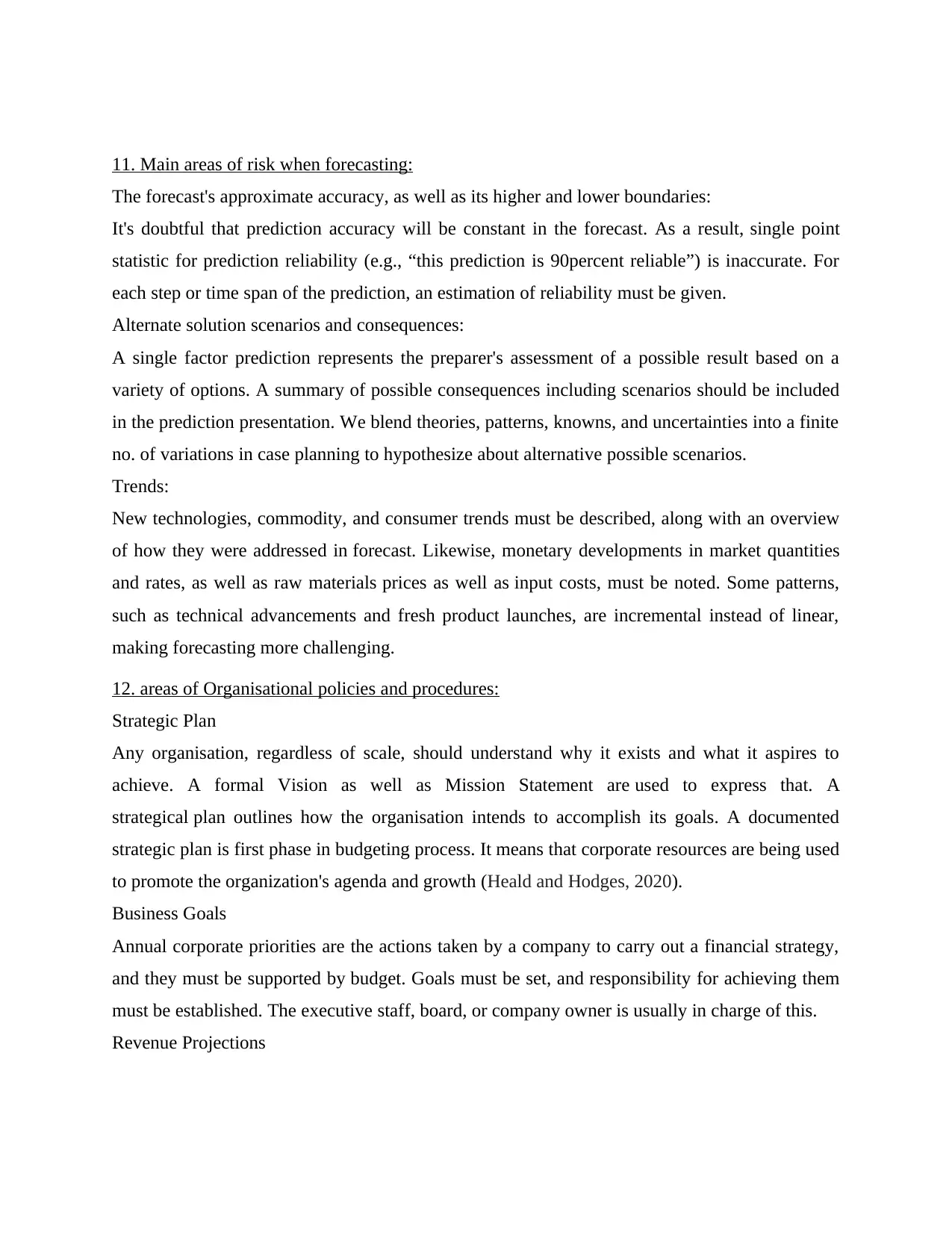
11. Main areas of risk when forecasting:
The forecast's approximate accuracy, as well as its higher and lower boundaries:
It's doubtful that prediction accuracy will be constant in the forecast. As a result, single point
statistic for prediction reliability (e.g., “this prediction is 90percent reliable”) is inaccurate. For
each step or time span of the prediction, an estimation of reliability must be given.
Alternate solution scenarios and consequences:
A single factor prediction represents the preparer's assessment of a possible result based on a
variety of options. A summary of possible consequences including scenarios should be included
in the prediction presentation. We blend theories, patterns, knowns, and uncertainties into a finite
no. of variations in case planning to hypothesize about alternative possible scenarios.
Trends:
New technologies, commodity, and consumer trends must be described, along with an overview
of how they were addressed in forecast. Likewise, monetary developments in market quantities
and rates, as well as raw materials prices as well as input costs, must be noted. Some patterns,
such as technical advancements and fresh product launches, are incremental instead of linear,
making forecasting more challenging.
12. areas of Organisational policies and procedures:
Strategic Plan
Any organisation, regardless of scale, should understand why it exists and what it aspires to
achieve. A formal Vision as well as Mission Statement are used to express that. A
strategical plan outlines how the organisation intends to accomplish its goals. A documented
strategic plan is first phase in budgeting process. It means that corporate resources are being used
to promote the organization's agenda and growth (Heald and Hodges, 2020).
Business Goals
Annual corporate priorities are the actions taken by a company to carry out a financial strategy,
and they must be supported by budget. Goals must be set, and responsibility for achieving them
must be established. The executive staff, board, or company owner is usually in charge of this.
Revenue Projections
The forecast's approximate accuracy, as well as its higher and lower boundaries:
It's doubtful that prediction accuracy will be constant in the forecast. As a result, single point
statistic for prediction reliability (e.g., “this prediction is 90percent reliable”) is inaccurate. For
each step or time span of the prediction, an estimation of reliability must be given.
Alternate solution scenarios and consequences:
A single factor prediction represents the preparer's assessment of a possible result based on a
variety of options. A summary of possible consequences including scenarios should be included
in the prediction presentation. We blend theories, patterns, knowns, and uncertainties into a finite
no. of variations in case planning to hypothesize about alternative possible scenarios.
Trends:
New technologies, commodity, and consumer trends must be described, along with an overview
of how they were addressed in forecast. Likewise, monetary developments in market quantities
and rates, as well as raw materials prices as well as input costs, must be noted. Some patterns,
such as technical advancements and fresh product launches, are incremental instead of linear,
making forecasting more challenging.
12. areas of Organisational policies and procedures:
Strategic Plan
Any organisation, regardless of scale, should understand why it exists and what it aspires to
achieve. A formal Vision as well as Mission Statement are used to express that. A
strategical plan outlines how the organisation intends to accomplish its goals. A documented
strategic plan is first phase in budgeting process. It means that corporate resources are being used
to promote the organization's agenda and growth (Heald and Hodges, 2020).
Business Goals
Annual corporate priorities are the actions taken by a company to carry out a financial strategy,
and they must be supported by budget. Goals must be set, and responsibility for achieving them
must be established. The executive staff, board, or company owner is usually in charge of this.
Revenue Projections
Paraphrase This Document
Need a fresh take? Get an instant paraphrase of this document with our AI Paraphraser
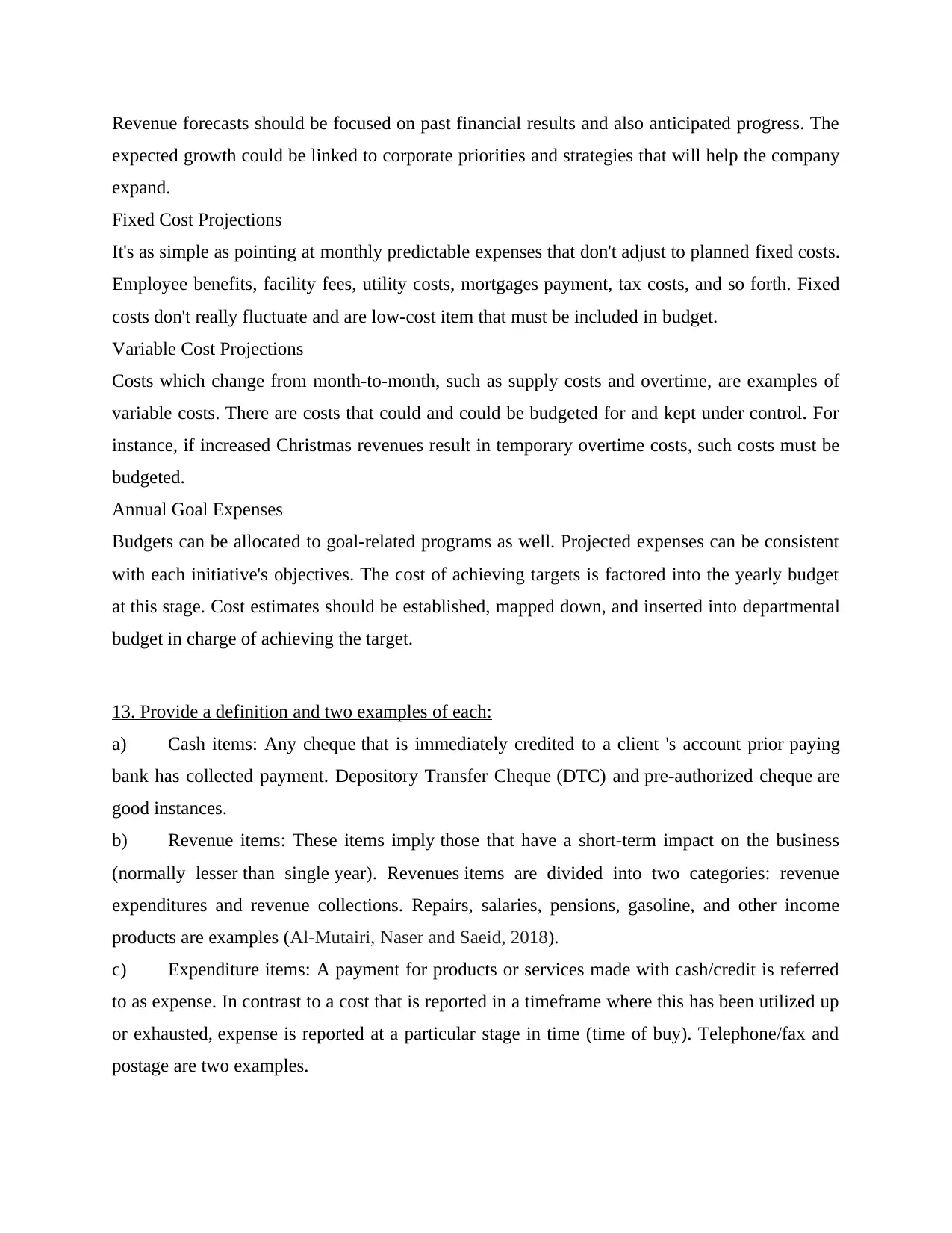
Revenue forecasts should be focused on past financial results and also anticipated progress. The
expected growth could be linked to corporate priorities and strategies that will help the company
expand.
Fixed Cost Projections
It's as simple as pointing at monthly predictable expenses that don't adjust to planned fixed costs.
Employee benefits, facility fees, utility costs, mortgages payment, tax costs, and so forth. Fixed
costs don't really fluctuate and are low-cost item that must be included in budget.
Variable Cost Projections
Costs which change from month-to-month, such as supply costs and overtime, are examples of
variable costs. There are costs that could and could be budgeted for and kept under control. For
instance, if increased Christmas revenues result in temporary overtime costs, such costs must be
budgeted.
Annual Goal Expenses
Budgets can be allocated to goal-related programs as well. Projected expenses can be consistent
with each initiative's objectives. The cost of achieving targets is factored into the yearly budget
at this stage. Cost estimates should be established, mapped down, and inserted into departmental
budget in charge of achieving the target.
13. Provide a definition and two examples of each:
a) Cash items: Any cheque that is immediately credited to a client 's account prior paying
bank has collected payment. Depository Transfer Cheque (DTC) and pre-authorized cheque are
good instances.
b) Revenue items: These items imply those that have a short-term impact on the business
(normally lesser than single year). Revenues items are divided into two categories: revenue
expenditures and revenue collections. Repairs, salaries, pensions, gasoline, and other income
products are examples (Al-Mutairi, Naser and Saeid, 2018).
c) Expenditure items: A payment for products or services made with cash/credit is referred
to as expense. In contrast to a cost that is reported in a timeframe where this has been utilized up
or exhausted, expense is reported at a particular stage in time (time of buy). Telephone/fax and
postage are two examples.
expected growth could be linked to corporate priorities and strategies that will help the company
expand.
Fixed Cost Projections
It's as simple as pointing at monthly predictable expenses that don't adjust to planned fixed costs.
Employee benefits, facility fees, utility costs, mortgages payment, tax costs, and so forth. Fixed
costs don't really fluctuate and are low-cost item that must be included in budget.
Variable Cost Projections
Costs which change from month-to-month, such as supply costs and overtime, are examples of
variable costs. There are costs that could and could be budgeted for and kept under control. For
instance, if increased Christmas revenues result in temporary overtime costs, such costs must be
budgeted.
Annual Goal Expenses
Budgets can be allocated to goal-related programs as well. Projected expenses can be consistent
with each initiative's objectives. The cost of achieving targets is factored into the yearly budget
at this stage. Cost estimates should be established, mapped down, and inserted into departmental
budget in charge of achieving the target.
13. Provide a definition and two examples of each:
a) Cash items: Any cheque that is immediately credited to a client 's account prior paying
bank has collected payment. Depository Transfer Cheque (DTC) and pre-authorized cheque are
good instances.
b) Revenue items: These items imply those that have a short-term impact on the business
(normally lesser than single year). Revenues items are divided into two categories: revenue
expenditures and revenue collections. Repairs, salaries, pensions, gasoline, and other income
products are examples (Al-Mutairi, Naser and Saeid, 2018).
c) Expenditure items: A payment for products or services made with cash/credit is referred
to as expense. In contrast to a cost that is reported in a timeframe where this has been utilized up
or exhausted, expense is reported at a particular stage in time (time of buy). Telephone/fax and
postage are two examples.
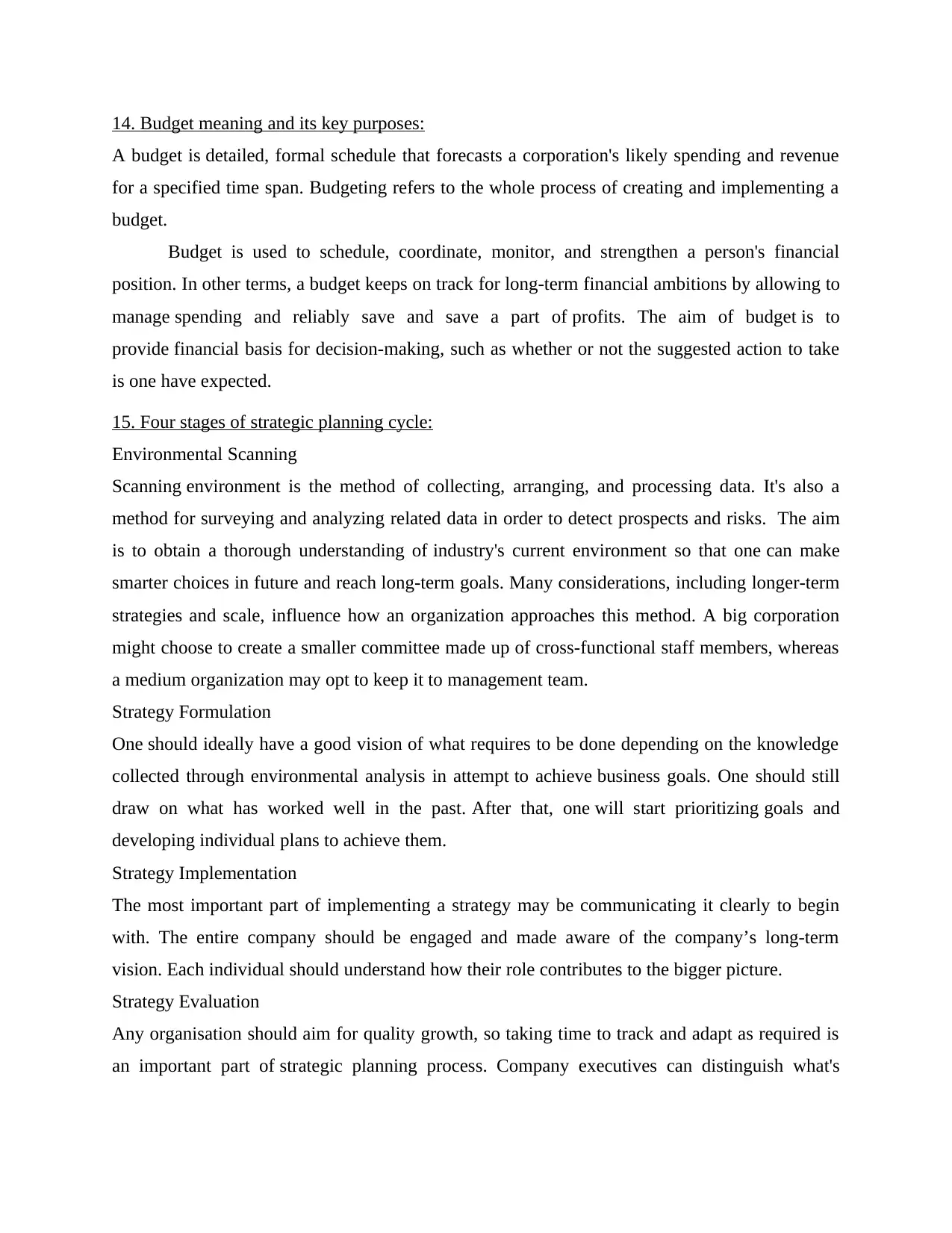
14. Budget meaning and its key purposes:
A budget is detailed, formal schedule that forecasts a corporation's likely spending and revenue
for a specified time span. Budgeting refers to the whole process of creating and implementing a
budget.
Budget is used to schedule, coordinate, monitor, and strengthen a person's financial
position. In other terms, a budget keeps on track for long-term financial ambitions by allowing to
manage spending and reliably save and save a part of profits. The aim of budget is to
provide financial basis for decision-making, such as whether or not the suggested action to take
is one have expected.
15. Four stages of strategic planning cycle:
Environmental Scanning
Scanning environment is the method of collecting, arranging, and processing data. It's also a
method for surveying and analyzing related data in order to detect prospects and risks. The aim
is to obtain a thorough understanding of industry's current environment so that one can make
smarter choices in future and reach long-term goals. Many considerations, including longer-term
strategies and scale, influence how an organization approaches this method. A big corporation
might choose to create a smaller committee made up of cross-functional staff members, whereas
a medium organization may opt to keep it to management team.
Strategy Formulation
One should ideally have a good vision of what requires to be done depending on the knowledge
collected through environmental analysis in attempt to achieve business goals. One should still
draw on what has worked well in the past. After that, one will start prioritizing goals and
developing individual plans to achieve them.
Strategy Implementation
The most important part of implementing a strategy may be communicating it clearly to begin
with. The entire company should be engaged and made aware of the company’s long-term
vision. Each individual should understand how their role contributes to the bigger picture.
Strategy Evaluation
Any organisation should aim for quality growth, so taking time to track and adapt as required is
an important part of strategic planning process. Company executives can distinguish what's
A budget is detailed, formal schedule that forecasts a corporation's likely spending and revenue
for a specified time span. Budgeting refers to the whole process of creating and implementing a
budget.
Budget is used to schedule, coordinate, monitor, and strengthen a person's financial
position. In other terms, a budget keeps on track for long-term financial ambitions by allowing to
manage spending and reliably save and save a part of profits. The aim of budget is to
provide financial basis for decision-making, such as whether or not the suggested action to take
is one have expected.
15. Four stages of strategic planning cycle:
Environmental Scanning
Scanning environment is the method of collecting, arranging, and processing data. It's also a
method for surveying and analyzing related data in order to detect prospects and risks. The aim
is to obtain a thorough understanding of industry's current environment so that one can make
smarter choices in future and reach long-term goals. Many considerations, including longer-term
strategies and scale, influence how an organization approaches this method. A big corporation
might choose to create a smaller committee made up of cross-functional staff members, whereas
a medium organization may opt to keep it to management team.
Strategy Formulation
One should ideally have a good vision of what requires to be done depending on the knowledge
collected through environmental analysis in attempt to achieve business goals. One should still
draw on what has worked well in the past. After that, one will start prioritizing goals and
developing individual plans to achieve them.
Strategy Implementation
The most important part of implementing a strategy may be communicating it clearly to begin
with. The entire company should be engaged and made aware of the company’s long-term
vision. Each individual should understand how their role contributes to the bigger picture.
Strategy Evaluation
Any organisation should aim for quality growth, so taking time to track and adapt as required is
an important part of strategic planning process. Company executives can distinguish what's
⊘ This is a preview!⊘
Do you want full access?
Subscribe today to unlock all pages.

Trusted by 1+ million students worldwide
1 out of 14
Related Documents
Your All-in-One AI-Powered Toolkit for Academic Success.
+13062052269
info@desklib.com
Available 24*7 on WhatsApp / Email
![[object Object]](/_next/static/media/star-bottom.7253800d.svg)
Unlock your academic potential
Copyright © 2020–2025 A2Z Services. All Rights Reserved. Developed and managed by ZUCOL.





